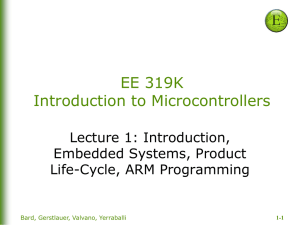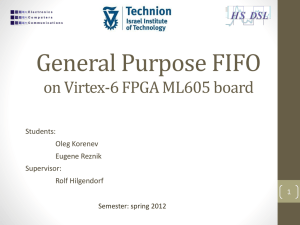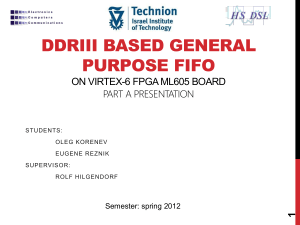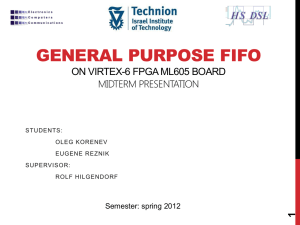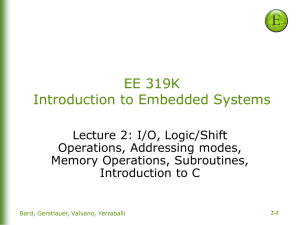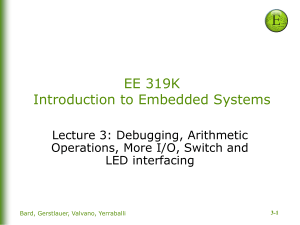Lec12
advertisement
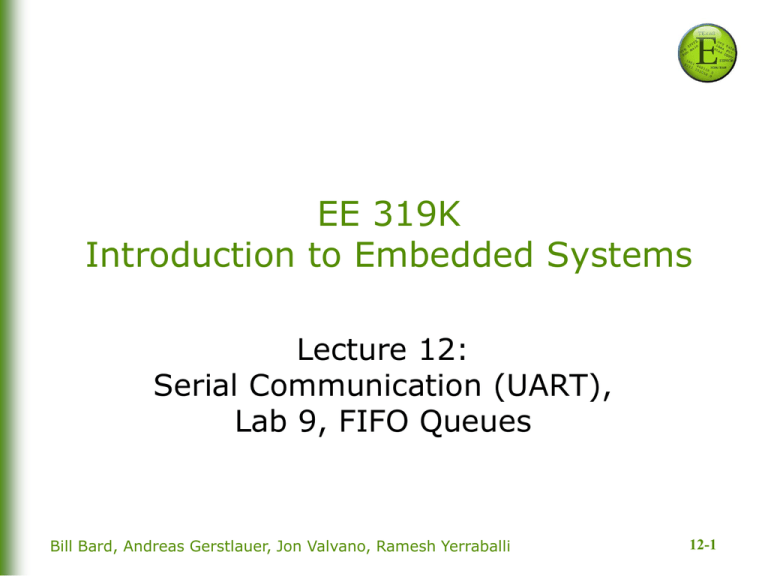
EE 319K
Introduction to Embedded Systems
Lecture 12:
Serial Communication (UART),
Lab 9, FIFO Queues
Bill Bard, Andreas Gerstlauer, Jon Valvano, Ramesh Yerraballi
12-1
Agenda
Recap
ADC, fixed-point
Assembly-C mix
Lab 8
Agenda
Communication
Serial: UART, interrupts
FIFO Queues used as buffers in communication
Lab 9: Distributing Lab 8
o Transmitter uses ADC to read potentiometer
o Receiver uses LCD to display position.
o FIFO serves as buffer at receiver
Bill Bard, Andreas Gerstlauer, Jon Valvano, Ramesh Yerraballi
12-2
Universal Asynchronous
Receiver/Transmitter (UART)
UART (Serial Port) Interface
One frame
Serial port
Start b b b b b b
b 7 Stop
0
2 3 4
1
5 b6
3.3V
0V
Send/receive a frame of (5-8) data bits with a
single (start) bit prefix and a 1 or 2 (stop) bit
suffix
Baud rate is total number of bits per unit time
o Baudrate = 1 / bit-time
Bandwidth is data per unit time
o Bandwidth = (data-bits / frame-bits) * baudrate
Bill Bard, Andreas Gerstlauer, Jon Valvano, Ramesh Yerraballi
12-3
TM4C123 LaunchPad I/O Pins
IO
PA2
PA3
PA4
PA5
PA6
PA7
PB0
PB1
PB2
PB3
PB4
PB5
PB6
PB7
PC4
PC5
PC6
PC7
PD0
PD1
PD2
PD3
PD6
PD7
PE0
PE1
PE2
PE3
PE4
PE5
PF0
PF1
PF2
PF3
Ain
Ain10
Ain11
C1C1+
C0+
C0Ain7
Ain6
Ain5
Ain4
Ain3
Ain2
Ain1
Ain0
Ain9
Ain8
0
Port
Port
Port
Port
Port
Port
Port
Port
Port
Port
Port
Port
Port
Port
Port
Port
Port
Port
Port
Port
Port
Port
Port
Port
Port
Port
Port
Port
Port
Port
Port
Port
Port
Port
1
2
SSI0Clk
SSI0Fss
SSI0Rx
SSI0Tx
3
4
I2C1SCL
I2C1SDA
5
6
I2C0SCL
I2C0SDA
U4Rx
U4Tx
U3Rx
U3Tx
SSI3Clk
SSI3Fss
SSI3Rx
SSI3Tx
U2Rx
U2Tx
U7Rx
U7Tx
M0PWM2
M0PWM3
M0PWM0
M0PWM1
M0PWM6
M0PWM7
IDX1
PhA1
PhB1
SSI1Clk I2C3SCL M0PWM6 M1PWM0
SSI1Fss I2C3SDA M0PWM7 M1PWM1
SSI1Rx
M0Fault0
SSI1Tx
IDX0
M0Fault0
PhA0
PhB0
U5Rx
U5Tx
U1RTS SSI1Rx
U1CTS SSI1Tx
SSI1Clk
SSI1Fss
8
9
14
M1PWM2
M1PWM3
U1Rx
U1Tx
SSI2Clk
SSI2Fss
SSI2Rx
SSI2Tx
U1Rx
U1Tx
7
I2C2SCL M0PWM4 M1PWM2
I2C2SDA M0PWM5 M1PWM3
CAN0Rx
M1PWM4 PhA0
M1PWM5 PhB0
M0Fault0 M1PWM6
CAN0Tx
M1PWM7
T2CCP0
T2CCP1
T3CCP0
T3CCP1
T1CCP0
T1CCP1
T0CCP0
T0CCP1
WT0CCP0
WT0CCP1
WT1CCP0
WT1CCP1
WT2CCP0
WT2CCP1
WT3CCP0
WT3CCP1
WT5CCP0
WT5CCP1
T0CCP0
T0CCP1
T1CCP0
T1CCP1
CAN0Rx
CAN0Tx
U1RTS
U1CTS
USB0epen
USB0pflt
USB0epen
USB0pflt
NMI
CAN0Rx
CAN0Tx
NMI
C0o
C1o
TRD1
TRD0
TRCLK
12-4
RS-232 Serial Port
+3.3V
0.1F
16
0.1F
TM4C123
0.1F
PA1/U0Tx
0
PA0/U1Rx
PB1/U1Tx
PB0/U1Rx
PD7/U2Tx
PD6/U2Rx
DB25
Pin
2
3
7
RS232
Name
BA
BB
AB
DB9
Pin
3
2
5
RxD
MAX
3232
3
4
DB9 female
0.1F
1
2
+5.5V
6 -5.5V
Vss
5
9
0.1F
5
4
8
9
Sin
8
3
TxD
10
7
Sout
7
2
6
15
EIA-574
Name
103
104
102
Signal
TxD
RxD
SG
1
Description
True
DTE
DCE
Transmit Data
Receive Data
Signal Ground
-5.5V
-5.5V
out
in
in
out
// this U1Tx PD3 not connected
// this U1Rx PD2 tied to U1Tx PD3 of other microcontroller
Bill Bard, Andreas Gerstlauer, Jon Valvano, Ramesh Yerraballi
12-5
Serial I/O
Serial communication
Transmit Data (TxD), Receive Data (RxD),
and Signal Ground (SG) implement duplex
communication link
Both communicating devices must operate at
the same bit rate
Least significant bit sent first
Full duplex
Half duplex
Simplex
Bill Bard, Andreas Gerstlauer, Jon Valvano, Ramesh Yerraballi
12-6
UART - Transmitter
Stop 7 6 5 4 3 2 1 0 Start
Shift
clock
1
Data
U0Tx
0
Transmit shift register
16-element
FIFO
TXEF Fifo empty flag
TXFF Fifo full flag
Write data
UART0_DR_R
Transmit data register
Bill Bard, Andreas Gerstlauer, Jon Valvano, Ramesh Yerraballi
12-7
UART - Transmitter
Tx Operation
Data written to UART0_DR_R
o passes through 16-element FIFO
o permits small amount of data rate matching
between processor and UART
Shift clock is generated from 16x clock
o permits differences in Tx and Rx clocks to be
reconciled
One frame
Serial port
Start b b b b b b
b 7 Stop
0
2 3 4
1
5 b6
Bill Bard, Andreas Gerstlauer, Jon Valvano, Ramesh Yerraballi
3.3V
0V
12-8
UART - Receiver
Stop 7 6 5 4 3 2 1 0 Start
Shift
clock
1
Data
OE BE PE FE
0
U0Rx
Receive shift register
12-bit, 16-element
FIFO
Read data
RXFE Fifo empty flag
RXFF Fifo full flag
UART0_DR_R
Receive data register
Bill Bard, Andreas Gerstlauer, Jon Valvano, Ramesh Yerraballi
12-9
UART - Receiver
Rx Operation
RXFE is 0 when data are available
RXFF is 1 when FIFO is full
FIFO entries have four control bits
o BE set when Tx signal held low for more than one
frame (break)
o OE set when FIFO is full and new frame has
arrived
o PE set if frame parity error
o FE set if stop bit timing error
One frame
Serial port
Start b b b b b b
b 7 Stop
0
2 3 4
1
5 b6
Bill Bard, Andreas Gerstlauer, Jon Valvano, Ramesh Yerraballi
3.3V
0V
12-10
UART – Overrun Error
"A"=$41
"B"=$42
CDEFGHIJKLMNO
s 0 1 2 3 4 5 6 7 s s 0 1 2 3 4 5 6 7 s
"P"=$50
"Q"=$51
s 0 1 2 3 4 5 6 7 s s 0 1 2 3 4 5 6 7 s
RXFE=0
OE=1
RXFF=1
17 frames transmitted and none read
=> overrun error
Bill Bard, Andreas Gerstlauer, Jon Valvano, Ramesh Yerraballi
12-11
TM4C UART0 – Registers
31–12
$4000.C000
11
OE
10
BE
9
PE
31–3
$4000.C004
31–8
$4000.C018
7
TXFE
6
RXFF
5
TXFF
31–16
8
FE
7–0
DATA
3
OE
2
BE
4
RXFE
3
BUSY
$4000.C030
$4000.C038
$4000.C03C
$4000.C040
$4000.C044
UART0_FBRD_R
6–5
WPEN
4
FEN
3
STP2
2
EPS
1
PEN
0
BRK
9
RXE
8
TXE
7
LBE
6–3
2
SIRLP
1
SIREN
0
UARTEN
5-3
RXIFLSEL
$4000.C034
31-11
UART0_FR_R
7
SPS
31–6
10
OEIM
OERIS
OEMIS
OEIC
9
BEIM
BERIS
BEMIS
BEIC
8
PEIM
PERIS
PEMIS
PEIC
7
FEIM
FERIS
FEMIS
FEIC
UART0_RSR_R
2–0
5–0
DIVFRAC
$4000.C028
31–10
0
FE
UART0_IBRD_R
31–6
$4000.C02C
1
PE
15–0
DIVINT
$4000.C024
31–8
Name
UART0_DR_R
6
RTIM
RTRIS
RTMIS
RTIC
2-0
TXIFLSEL
5
TXIM
TXRIS
TXMIS
TXIC
Bill Bard, Andreas Gerstlauer, Jon Valvano, Ramesh Yerraballi
4
RXIM
RXRIS
RXMIS
RXIC
UART0_LCRH_R
UART0_CTL_R
UART0_IFLS_R
UART0_IM_R
UART0_RIS_R
UART0_MIS_R
UART0_IC_R
12-12
TM4C UART Setup
UART0 operation
UART clock started in SYSCTL_RCGCUART_R
Digital port clock started in SYSCTL_RCGCGPIO_R
UART0_CTL_R contains UART enable (UARTEN), Tx (TXE), and Rx
enable (RXE)
o set each to 1 to enable
o UART disabled during initialization
UART0_IBRD_R and UART_FBRD_R specify baud rate
o bit rate = (bus clock frequency)/(16*divider)
o ex: want 19.2 kb/s and bus clock is 8 MHz
o 8 MHz/(16*19.2 k) = 26.04167 = 11010.0000112
o Tx and Rx clo ck rates must be within 5% to avoid errors
GPIO_PORTA_AFSEL_R to choose alternate function
Write appropriate values to GPIO_PORTA_PCTL_R (See slide 4)
GPIO_PORTA_DEN_R Enable digital I/O on pins 1-0
GPIO_PORTA_AMSEL_R no Analog I/O on pins 1-0
write to UART0_LCRH_R to activate
Bill Bard, Andreas Gerstlauer, Jon Valvano, Ramesh Yerraballi
12-13
UART Setup
// Assumes a 50 MHz bus clock, creates 115200 baud rate
void UART_Init(void){
SYSCTL_RCGCUART_R |= 0x0001; // activate UART0
SYSCTL_RCGCGPIO_R |= 0x0001; // activate port A
UART0_CTL_R &= ~0x0001;
// disable UART
UART0_IBRD_R = 27;
// IBRD=int(50000000/(16*115,200)) = int(27.1267)
UART0_FBRD_R = 8;
// FBRD = round(0.1267 * 64) = 8
UART0_LCRH_R = 0x0070; // 8-bit length, enable FIFO
UART0_CTL_R = 0x0301;
// enable RXE, TXE and UART
GPIO_PORTA_AFSEL_R |= 0x03; // alt funct on PA1-0
GPIO_PORTA_PCTL_R =
(GPIO_PORTA_PCTL_R&0xFFFFFF00)+0x00000011;
GPIO_PORTA_DEN_R |= 0x03;
// digital I/O on PA1-0
GPIO_PORTA_AMSEL_R &= ~0x03; // No analog on PA1-0
}
Bill Bard, Andreas Gerstlauer, Jon Valvano, Ramesh Yerraballi
12-14
UART Synchronization
Busy-wait operation
InChar
Empty
1
RXFE
0
OutChar
Full
1
Not empty
TXFF
0
Not full
Read data
Write data
return
return
Bill Bard, Andreas Gerstlauer, Jon Valvano, Ramesh Yerraballi
12-15
UART Busy-Wait Send/Recv
// Wait for new input,
// then return ASCII code
uint8_t UART_InChar(void) {
while((UART0_FR_R&0x0010) != 0);
// wait until RXFE is 0
return((uint8_t)(UART0_DR_R&0xFF));
}
// Wait for buffer to be not full,
// then output
void UART_OutChar(uint8_t data) {
while((UART0_FR_R&0x0020) != 0);
// wait until TXFF is 0
UART0_DR_R = data;
}
Bill Bard, Andreas Gerstlauer, Jon Valvano, Ramesh Yerraballi
12-16
UART Interrupts
UART0_IFLS_R register (bits 5,4,3)
RXIFLSEL
0x0
0x1
0x2
0x3
0x4
RX FIFO
≥ ⅛ full
≥ ¼ full
≥ ½ full
≥ ¾ full
≥ ⅞ full
Set RXRIS interrupt trigger when
Receive FIFO goes from 1 to 2 characters
Receive FIFO goes from 3 to 4 characters
Receive FIFO goes from 7 to 8 characters
Receive FIFO goes from 11 to 12 characters
Receive FIFO goes from 13 to 14 characters
TXIFLSEL
0x0
0x1
0x2
0x3
0x4
TX FIFO
≤ ⅞ empty
≤ ¾ empty
≤ ½ empty
≤ ¼ empty
≤ ⅛ empty
Set TXRIS interrupt trigger when
Transmit FIFO goes from 15 to 14 characters
Transmit FIFO goes from 13 to 12 characters
Transmit FIFO goes from 9 to 8 characters
Transmit FIFO goes from 5 to 4 characters
Transmit FIFO goes from 3 to 2 characters
Bill Bard, Andreas Gerstlauer, Jon Valvano, Ramesh Yerraballi
12-17
Lab 9 – Distributed Measurement
Position Voltage
0 to 3 cm 0 to +3.3V
Position
Sensor
ADC
hardware
STX d1 .
ADC
driver
Sample
0 to 4095
d2 d3 d4 CR ETX
Message
SysTick
ISR
Message
UART
driver
SysTick
hardware
Computer 1
Fixed-point
0 to 3.000
Computer 2
LCD
display
Message
Sample
0 to 4095
LCD
driver
main
UART1
hardware
Message
Message
Message
FIFO
Bill Bard, Andreas Gerstlauer, Jon Valvano, Ramesh Yerraballi
Message
UART1
ISR
UART1
hardware
12-18
Lab9: Transmitter SysTick ISR
Toggle heartbeat
Busy-wait version
Sample ADC
Toggle heartbeat
Convert to integer part of fixed point
Send message, 8 calls to UART_OutChar
STX
Ones digit
Decimal point
Tenths digit
Hundreds digit
Thousandth digit
CR
ETX
Busy-wait version
Interrupt
Perform I/O
return from interrupt
Toggle heartbeat
Bill Bard, Andreas Gerstlauer, Jon Valvano, Ramesh Yerraballi
12-19
Lab9: UART Rx Interrupt
Interrupt Trigger, sets RXRIS
Receive FIFO has gone from 7 to 8 elements
(1/2 full)
Initialization (add these)
Arm RXRIS UART1_IM_R |= 0x10;
Set UART1_IFLS_R bits 5,4,3 to 010 (1/2 full)
NVIC_PRI1_R
// bits 21-23
NVIC_EN0_R // enable interrupt 6 in NVIC
Interrupt vector in startup.s
Name ISR UART1_Handler
Acknowledge (in ISR)
UART1_ICR_R = 0x10;
Bill Bard, Andreas Gerstlauer, Jon Valvano, Ramesh Yerraballi
12-20
Lab9: Interrupt+Mailbox?
Background thread
Foreground thread
RXRIS ISR
Main loop
Read UART1_DR_R
Store in RXmail
Set RXstatus
Main
program
ISR
Read data
from input
Other calculations a
Empty
c
Status
Wait for RXstatus
Read RXmail
Clear RXstatus
Convert to distance
Display on LCD
Mail = data
b
Status = Full
Full
Process Mail
Status = Empty
d
What can go wrong?
Bill Bard, Andreas Gerstlauer, Jon Valvano, Ramesh Yerraballi
12-21
First-In/First-Out (FIFO) Queues
Fifo_Put
Source process
Producer
Fifo_Get
FIFO
Sink process
Consumer
Order preserving
Producer(s) put (on tail end)
Consumer(s) get (from head end)
Buffer decouples producer & consumer
Even out temporary mismatch in rates
Bill Bard, Andreas Gerstlauer, Jon Valvano, Ramesh Yerraballi
12-22
FIFO Operation
I/O bound input interface
Input
device
busy
Interrupt
service
routine
Main
program
Elements
in FIFO
done
busy
done
b
a
empty
b
c
1
d
a
c
d
empty
1
empty
Bill Bard, Andreas Gerstlauer, Jon Valvano, Ramesh Yerraballi
a
12-23
FIFO Operation
High bandwidth input burst
Input
device
busy done busy done busy done busy done busy done
Interrupt
service
routine
Main
program
b
b
a
Elements empty
in FIFO
c
1
b
b
b
d
empty
1
c
2
Bill Bard, Andreas Gerstlauer, Jon Valvano, Ramesh Yerraballi
busy
3
d
2
3
12-24
FIFO Queue Synchronization
Input ISR
Input
Read data
from input
Empty
RxFifo
Not empty
Output ISR
RxFifo
RxFifo_Get
ERROR
Empty
TxFifo_Get
Full
RxFifo_Put
return
Output
Full
Not full
TxFifo
Not empty
TxFifo
Not full
TxFifo_Put
Write data
to output
Disarm
output
Arm output
return
Lab 9
Bill Bard, Andreas Gerstlauer, Jon Valvano, Ramesh Yerraballi
12-25
Lab 9 - RXRIS ISR
1.
2.
3.
4.
5.
6.
7.
toggle PF2 (change from 0 to 1, or from 1 to 0), heartbeat
toggle PF2 (change from 0 to 1, or from 1 to 0), heartbeat
as long as the RXFE bit in the UART1_FR_R is zero
o Read bytes from UART1_DR_R
o Put all bytes into your software FIFO, RxFifo_Put
o Should be exactly 8 bytes, but could be more possibly
o If your software FIFO is full (data lost)
increment a global error count (but don’t loop back)
o The message will be interpreted in the main program
Increment a Counter,
o debugging monitor of the number of UART messages received
acknowledge the interrupt by clearing the flag which requested it
o UART1_ICR_R = 0x10; // clears bit 4 (RXRIS) in RIS register
toggle PF2 (change from 0 to 1, or from 1 to 0), heartbeat
return from interrupt
Bill Bard, Andreas Gerstlauer, Jon Valvano, Ramesh Yerraballi
12-26
FIFO Queue Implementation
How is memory allocated?
FIFO implies that we write new data at the
head of the queue and we read data from
the tail of the queue
What problem does this cause?
To address that problem the queue is
operated in a circular manner
An array of locations is processed so that the
FIRST element of array appears to follow the
LAST element of the array
Bill Bard, Andreas Gerstlauer, Jon Valvano, Ramesh Yerraballi
12-27
FIFO Queue Implementation
Two parameters are needed to specify the
FIFO buffer (array)
FIRST (usually index 0)
o points to the first location of the buffer
LIMIT (usually index SIZE)
o points to last location+1 of the buffer
o since LIMIT is outside the buffer, data must not
be written there
FIRST and LIMIT are constants
o they are NOT modified by either the source or sink
processing routines
Bill Bard, Andreas Gerstlauer, Jon Valvano, Ramesh Yerraballi
12-28
FIFO Queue Implementation
RxFifo
GetPt
PutPt
Valid
data
PutPt: Points to the
location where the
next element to be
added goes
GetPt: Points to the
location of the oldest
valid element, hence
the element to be
removed first
Bill Bard, Andreas Gerstlauer, Jon Valvano, Ramesh Yerraballi
12-29
FIFO Full/Empty Conditions
FIFO Parameter Relations
Buffer is EMPTY
o PutPt equals GetPt
Buffer is FULL
o PutPt + 1 equals GetPt
note that there is no data stored at PutPt
as a result, if N locations are allocated for a buffer,
only N-1 data elements will fill the buffer
Bill Bard, Andreas Gerstlauer, Jon Valvano, Ramesh Yerraballi
12-30
FIFO Wrapping
Put
Put
Put
Put
PPt
FIRST
newest
PPt
newest
PPt
Pointer wrap
on 2nd put
GPt
GPt
PPt
GPt
oldest
oldest
GPt
oldest
GPt
oldest
newest
PPt
newest
LIMIT
Get
Get
Get
Get
GPt
newest
PPt
newest
PPt
newest
PPt
oldest
newest
PPt
FIRST
GPt
PPt
Pointer wrap
on 4th get
GPt
oldest
GPt
oldest
GPt
oldest
LIMIT
Bill Bard, Andreas Gerstlauer, Jon Valvano, Ramesh Yerraballi
12-31
FIFO Queue
FIFO Implementations
FIFO_Put
o stores a single value on the FIFO queue
operates with interrupts disabled
updates PutPt
detects buffer full condition
handles transition from LIMIT-1 to FIRST
FIFO_Get
o reads a single value from the FIFO queue
operates with interrupts disabled
updates GetPt
detects buffer empty condition
handles transition from LIMIT-1 to FIRST
Bill Bard, Andreas Gerstlauer, Jon Valvano, Ramesh Yerraballi
12-32
FIFO in C
#define
int32_t
int32_t
int32_t
FIFO_SIZE 10
static means
static *PutPt; private to this file
static *GetPt;
static Fifo[FIFO_SIZE];
void Fifo_Init(void){
PutPt = GetPt = &Fifo[0];
}
Bill Bard, Andreas Gerstlauer, Jon Valvano, Ramesh Yerraballi
12-33
FIFO Routines in C
int Fifo_Put(int32_t data)
Actually plus 4 bytes
{
int32_t *tempPt;
tempPt = PutPt+1;
// see if there is room
if(tempPt==&Fifo[FIFO_SIZE]){
tempPt = &Fifo[0];
}
if(tempPt == GetPt){
return(0);
// full!
}
else{
*(PutPt) = data;
// save
PutPt = tempPt;
// OK
return(1);
}
}
Bill Bard, Andreas Gerstlauer, Jon Valvano, Ramesh Yerraballi
12-34
FIFO Routines in C
int Fifo_Get(int32_t *datapt){
if(PutPt == GetPt){
return(0);
// Empty
}
Actually plus 4 bytes
else{
*datapt = *(GetPt++);
if(GetPt==&Fifo[FIFO_SIZE]){
GetPt = &Fifo[0];
}
return(1);
}
}
Bill Bard, Andreas Gerstlauer, Jon Valvano, Ramesh Yerraballi
12-35
FIFO Queue – Index Implementation
FIFO Implementations
FIFO_Put
o stores a single value on the FIFO queue
operates with interrupts disabled
updates PutI
detects buffer full condition
handles transition from LIMIT-1 to FIRST
FIFO_Get
o reads a single value from the FIFO queue
operates with interrupts disabled
updates GetI
detects buffer empty condition
handles transition from LIMIT-1 to FIRST
Bill Bard, Andreas Gerstlauer, Jon Valvano, Ramesh Yerraballi
12-36
FIFO in C – Index Implementation
static means
private to this file
#define FIFO_SIZE 10
int32_t static PutI; //Index in FIFO to
// put new item in
int32_t static GetI; //Index of oldest
// item in FIFO
int32_t static Fifo[FIFO_SIZE];
void Fifo_Init(void){
PutI = GetI = 0;
}
Bill Bard, Andreas Gerstlauer, Jon Valvano, Ramesh Yerraballi
12-37
FIFO in C – Index Implementation
int Fifo_Put(int32_t data)
{
if ( (PutI+1)% FIFO_SIZE) == GetI) {
return(0);
}
Full FIFO check
FIFO[PutI] = data;
PutI = (PutI+1)%FIFO_SIZE;
return(1);
}
int Fifo_Get(int32_t *datapt)
Empty FIFO check
{
if (GetI == PutI) {
return(0);
}
*datapt = FIFO[GetI];
GetI = (GetI+1)%FIFO_SIZE;
return(1);
}
Bill Bard, Andreas Gerstlauer, Jon Valvano, Ramesh Yerraballi
12-38
FIFO Full Errors
Average producer rate exceeds Producer rate temporarily
the average consumer rate
exceeds the consumer rate
Sample ADC every 50 ms
Sample ADC every 50
Average time to process the
ms
sample is 51 ms
Every 100th sample it
Solution: decrease producer
takes 1 sec to process
rate or increase consumer
Solution: increase FIFO
rate
queue size
o Lower sampling rate
o
o
o
o
Faster computer
More efficient compiler
Rewrite time-critical code
in assembly
More computers
(distributed processing)
Bill Bard, Andreas Gerstlauer, Jon Valvano, Ramesh Yerraballi
12-39

